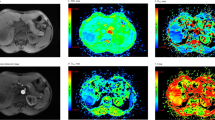Abstract
Purpose
The aim of this study was to determine the correlation between the liver and spleen apparent diffusion coefficient (ADC) values of patients with chronic liver disease and the presence and the degree of ascites.
Materials and method
In this retrospective study, we assessed 107 patients with chronic liver disease and 39 control subjects who underwent upper abdominal MR imaging including echo-planar diffusion-weighted imaging (DWI). Among the 107 cirrhotic patients, 56 were classified as group 1, 25 as group 2, and 26 as group 3 according to the absence, the presence of minimal, and the presence of massive ascites, respectively. The scores of model for end-stage liver disease (MELD) were matched between groups as the standard reference. The liver ADC, spleen ADC, and normalized liver ADC values were compared between the control group and patients’ groups.
Results
Patients with massive ascites had significantly higher MELD score compared with the other groups. The MELD score was also significantly higher in patient groups than in control group. The liver and normalized liver ADCs of patients’ groups were significantly lower than that of the control group. With some overlap among groups, the measured ADC values decreased as the amount of the ascites increased, and these relationships were statistically significant. Furthermore, compared to control group, patients with massive ascites had significantly higher spleen ADCs.
Conclusion
Our results indicate that the ADC value of the liver and spleen correlates with the presence and the degree of ascites in patients with chronic liver disease, and merits further study.



Similar content being viewed by others
References
Kamath PS, Wiesner RH, Malinchoc M, et al. (2001) A model to predict survival in patients with end-stage liver disease. Hepatology 33:464–470
Kamath PS, Kim WR, Advanced Liver Disease Study Group (2007) The model for end-stage liver disease (MELD). Hepatology 45:797–805
Ito K, Mitchell DG, Hann HW, et al. (1999) Viral-induced cirrhosis: grading of severity using MR imaging. Am J Roentgenol 173(3):591–596
Saygili OB, Tarhan NC, Yildirim T, et al. (2005) Value of computed tomography and magnetic resonance imaging for assessing severity of liver cirrhosis secondary to viral hepatitis. Eur J Radiol 54(3):400–407
Moreau R, Delègue P, Pessione F, et al. (2004) Clinical characteristics and outcome of patients with cirrhosis and refractory ascites. Liver Int 24(5):457–464
Do RK, Chandarana H, Felker E, et al. (2010) Diagnosis of liver fibrosis and cirrhosis with diffusion-weighted imaging: value of normalized apparent diffusion coefficient using the spleen as reference organ. Am J Roentgenol 195(3):671–676. doi:10.2214/AJR.09.3448
Qu JR, Li HL, Shao NN, et al. (2012) Additional diffusion-weighted imaging in the detection of new, very small hepatocellular carcinoma lesions after interventional therapy compared with conventional 3 T MRI alone. Clin Radiol 67(7):669–674
Le Moigne F, Durieux M, Bancel B, et al. (2012) Impact of diffusion-weighted MR imaging on the characterization of small hepatocellular carcinoma in the cirrhotic liver. Magn Reson Imaging 30(5):656–665
Koinuma M, Ohashi I, Hanafusa K, Shibuya H (2005) Apparent diffusion coefficient measurements with diffusion-weighted magnetic resonance imaging for evaluation of hepatic fibrosis. J Magn Reson Imaging 22(1):80–85
Taouli B, Koh DM (2010) Diffusion-weighted MR imaging of the liver. Radiology 254(1):47–66. doi:10.1148/radiol.09090021
Papanikolaou N, Gourtsoyianni S, Yarmenitis S, Maris T, Gourtsoyiannis N (2010) Comparison between two-point and four-point methods for quantification of apparent diffusion coefficient of normal liver parenchyma and focal lesions. Value of normalization with spleen. Eur J Radiol 73(2):305–309
Girometti R, Furlan A, Esposito G, et al. (2008) Relevance of b-values in evaluating liver fibrosis: a study in healthy and cirrhotic subjects using two single-shot spin-echo echo-planar diffusion-weighted sequences. J Magn Reson Imaging 28(2):411–419. doi:10.1002/jmri.21461
Nasu K, Kuroki Y, Sekiguchi R, Kazama T, Nakajima H (2006) Measurement of the apparent diffusion coefficient in the liver: is it a reliable index for hepatic disease diagnosis? Radiat Med 24(6):438–444
Haimerl M, Verloh N, Fellner C, et al. (2014) MRI-based estimation of liver function: Gd-EOB-DTPA-enhanced T1 relaxometry of 3T vs. the MELD score. Sci Rep 8(4):5621
Bülow R, Mensel B, Meffert P, et al. (2013) Diffusion-weighted magnetic resonance imaging for staging liver fibrosis is less reliable in the presence of fat and iron. Eur Radiol 23(5):1281–1287
Koh DM, Collins DJ (2007) Diffusion-weighted MRI in the body: applications and challenges in oncology. Am J Roentgenol 188(6):1622–1635
Tosun M, Inan N, Sarisoy HT, et al. (2013) Diagnostic performance of conventional diffusion weighted imaging and diffusion tensor imaging for the liver fibrosis and inflammation. Eur J Radiol 82(2):203–207 (Epub 2012 Nov 2). doi:10.1016/j.ejrad.2012.09.009
Klasen J, Lanzman RS, Wittsack HJ, et al. (2013) Diffusion-weighted imaging (DWI) of the spleen in patients with liver cirrhosis and portal hypertension. Magn Reson Imaging 31(7):1092–1096 (Epub 2013 Jun 2). doi:10.1016/j.mri.2013.01.003
Yoshikawa T, Kawamitsu H, Mitchell DG, et al. (2006) ADC measurement of abdominal organs and lesions using parallel imaging technique. Am J Roentgenol 187(6):1521–1530
Girometti R, Furlan A, Bazzocchi M, et al. (2007) Diffusion-weighted MRI in evaluating liver fibrosis: a feasibility study in cirrhotic patients. Radiol Med 112(3):394–408 (Epub 2007 Apr 20)
Chandarana H, Do RK, Mussi TC, et al. (2012) The effect of liver iron deposition on hepatic apparent diffusion coefficient values in cirrhosis. Am J Roentgenol 199(4):803–808
Author information
Authors and Affiliations
Corresponding author
Ethics declarations
Conflict of interest
The authors have not declared any conflict of interests.
Financial support
None.
Rights and permissions
About this article
Cite this article
Kahraman, A.S., Kahraman, B., Ozdemir, Z.M. et al. Diffusion-weighted imaging (DWI) of the liver in assessing chronic liver disease: effects of the presence and the degree of ascites on ADC values. Abdom Radiol 41, 56–62 (2016). https://doi.org/10.1007/s00261-015-0613-7
Published:
Issue Date:
DOI: https://doi.org/10.1007/s00261-015-0613-7




